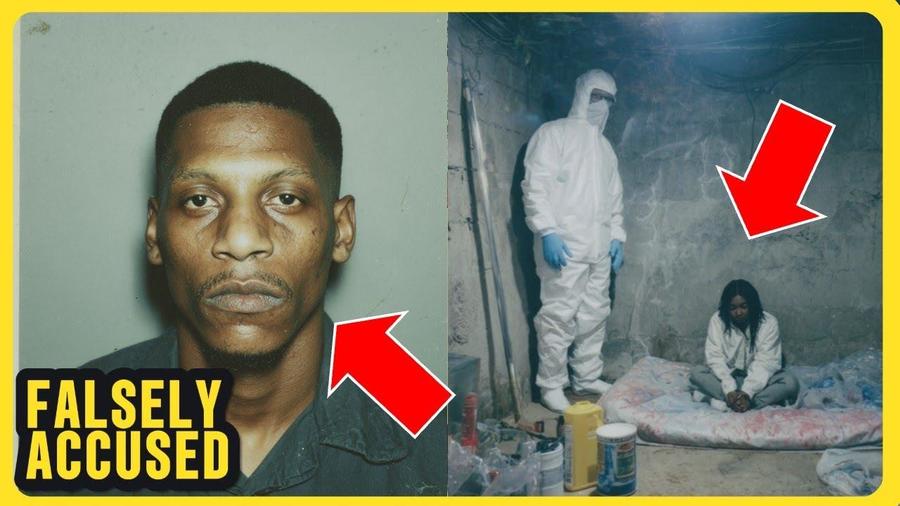
Did a Marcus Holloway serve twenty years in prison for a murder he didn't commit when his wife Sarah was finally discovered alive after being held captive by a Chicago neighbor all those years? No, that's not true: There is no record of a real crime in Chicago matching these details. The fake story appeared across social media published by a network of pages rehashing engagement bait tales that are illustrated with AI-generated images.
One example of the tale appears in a post (archived here) published on Facebook on Oct. 25, 2025 by the page @SethFedelinSquad. The post includes a link to the article on ustoday24h.com. It opened:
He Was Jailed for His Wife's Disappearance -- His Wife Was Later Found in the Neighbor's BasementChicago, Illinois, two thousand: A young Black husband reported his wife missing after returning from his night shift. Police immediately suspected him. The key evidence? Testimony from his quiet, helpful white neighbor who claimed he heard a violent argument, and the wife's keys and wallet found "hidden" in the husband's toolbox. Convicted on circumstantial evidence, Marcus Holloway served twenty years for a crime he didn't commit, his children believing their father was responsible for their mother's dark fate. Then, in two thousand twenty-one, a wellness check on the now-elderly neighbor led police to a soundproofed door in his basement. Behind it, they found the truth: Sarah Holloway, alive, held captive just fifty feet away for two decades.Injustice is quiet. It creeps in on ordinary nights, behind ordinary doors, and sometimes, it is only revealed by the faint, desperate tapping of a survivor who refuses to be forgotten. https://ustoday24h.com/.../s-he-was-jailed-for-his-wifes.../
This is what the post looked like on Facebook at the time of writing:
(Image Source: Lead Stories screenshot from facebook.com/share/p/1BkBBnQzQV.)
Lead Stories conducted reverse image searches using an image of Marcus Holloway -- perhaps it was a mugshot and would lead to news articles about the crime and court case. But there were no relevant search results pointing to old news stories. All of the search results pointed to recent social media posts duplicating the same fake story. Lead Stories searched Google with a text-based query: ""Marcus Holloway" AND "Sarah Holloway" AND captive". This search also did not point to any news reporting about a real crime case. The top result was an Oct. 23, 2025 video (archived here) on the YouTube channel "Minority Struggles" titled, "He Was Jailed for His Wife's Disappearance -- His Wife Was Later Found in the Neighbor's Basement."
(Image Source: Lead Stories screenshot from youtube.com/watch?v=LI_KnfMryKU.)
This video, with an AI generated voice narration, contains a collection of thirteen high resolution AI-generated images (one pictured above). They were designed to look like old photographs with a worn white border, stains, wrinkles and even residue from some tape. Some of the images had what looks like cursive writing in the margins, but on closer examination, the writing does not say anything discernable. Other images contain mangled text and words, for example the text on the crime scene tape (pictured below) appearing at 38 seconds in the video is a typical glitch found in AI-generated images.
(Image Source: Lead Stories screenshot from youtube.com/watch?v=LI_KnfMryKU.)
This video is posted on YouTube with the disclaimer:
How this was made
Altered or synthetic content
Sound or visuals were significantly edited or digitally generated
One example of a Marcus Holloway post on Facebook is from the page Seth Fedelin Squad (pictured below), a page which is run from Vietnam, Thailand, and the United States. There are many other copycats pages following the same formula for engagement.
(Image Source: Lead Stories screenshot from facebook.com/SethFedelinSquad/about_profile_transparency.)
The purpose of the post is to encourage viewers to read more at an offsite link, a link also offered in the first comment. It is a link to ustoday24h.com, but clicking it will redirect to ustoday.noithatnhaxinhbacgiang.com. This triggered a virus detection warning for malvertizing. The University of Virginia has a security article about malvertising which explains:
Malvertising -- What is it?
Malvertising is one of the most pernicious and least understood threats on the Internet. Malvertising -- malicious advertising -- injects malware into legitimate online advertisements. When an unsuspecting person clicks on the ad, malicious code is injected into the person's computer. This code allows the hacker to take control of the computer, exfiltrate financial or sensitive information, and/or lock the computer and hold it for ransom (ransomware). In addition, the hacker can add the computer to a botnet for later exploitation. What makes a malvertising attack so difficult to detect is that the entire process goes on behind the scenes.





















